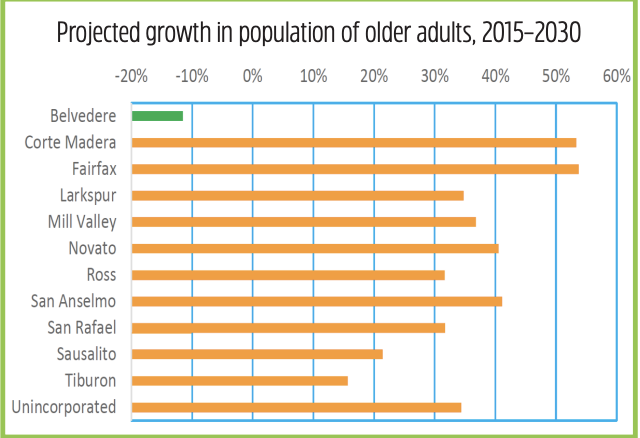Housing Needs for Seniors
Lack of Accessible Housing Threatens Well-Being of Marin’s Older Adults
Marin County’s population of older residents has skyrocketed in the past decade, leaving our county far and away the oldest in the Bay Area. By 2041, almost half our population is expected to be above 60. Less than 1% of current housing stock in Marin is built to be accessible, and even fewer units are both affordable and accessible. We need more housing to serve our aging population
Our lack of affordable housing creates unacceptable financial risks for older residents: 41% of Marin households with senior residents were low-income. Many older residents on fixed incomes cannot keep up with rents that increase faster than inflation. This becomes even more challenging when in-home assistance is required. As housing prices in Marin climb and elderly individuals on fixed incomes require increasingly expensive daily assistance, countless residents could be pushed out onto the streets. Many older residents end up paying more in rent than their income. As their savings are depleted, some hope that they can scrape by and that their funds can last as long as they do. Others leave the community they’ve lived in for decades and try to start new in a less expensive location. And some become homeless. Already, a third of our homeless are over the age of 50.
The Marin Civil Grand Jury determined housing is the solution: In its report criticizing Marin for the escalating homeless rate among senior residents, the Civil Grand Jury argued that “Stabilizing housing for older adults is the best way to spare them the pain, suffering, humiliation, and indignity of becoming homeless.”

Less than 1% of Marin housing stock is accessible: Most of Marin’s housing was built long before accessibility standards were adopted. Further, accessibility standards don’t apply to single family homes. Many residents don’t have the option to downsize to meet their needs.
Many older residents can’t or don’t want to “age in place”: Aging residents in Marin County commonly live in larger, single-family homes that are difficult to keep up, lack adequate accessibility accommodations, and are too distant from basic services. Those who can’t drive are often shut out of community life.
Our healthcare shortage hurts all of us, especially older adults: Because healthcare workers cannot afford Marin’s high cost of housing, adequate staffing has become an increasing challenge. Caretakers are especially difficult to recruit and retain, due to low wages and long commutes., Even doctors are reluctant to relocate to Marin, as the quality of housing is very low compared to the cost. As a result, Marinites pay higher costs to cover commuting and housing costs, and staffing shortages are common.

